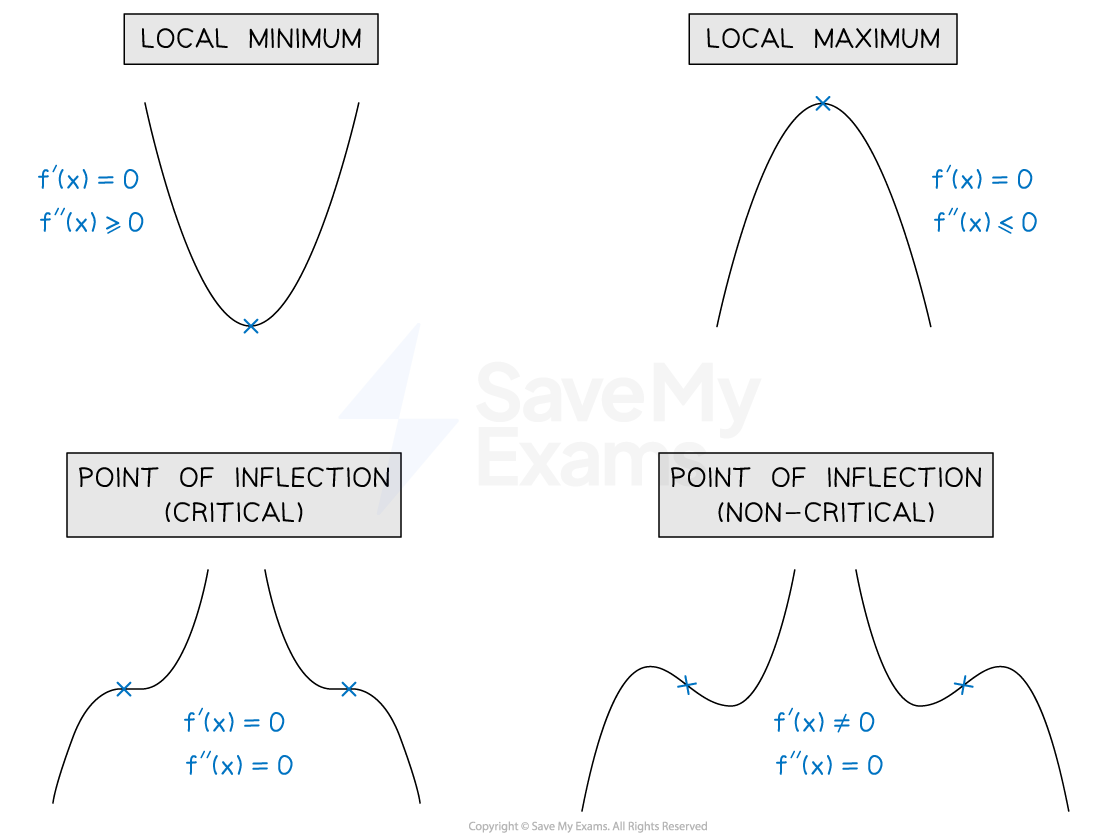Second Derivative Test for Local Extrema (College Board AP® Calculus AB): Study Guide
Second derivative test
First and second derivatives at key points
To be able to classify key points on the graph of a function, it is important that you are confident with the properties of the first and second derivatives at these points
Type of point | First derivative | Second derivative |
|---|---|---|
Local minimum | Zero | Positive or zero |
Local maximum | Zero | Negative or zero |
Point of inflection (critical) | Zero | Zero |
Point of inflection (non-critical) | Non-zero | Zero |

What is the second derivative test?
The information above means the second derivative can be used to determine if a critical point is a local minimum or maximum
The second derivative test states that:
If
and
,
then
has a local minimum at
If
and
,
then
has a local maximum at
If
and
then this test does not give any information
it could be any of a local minimum, local maximum, or point of inflection
Which points have a second derivative of zero?
All points of inflection have a second derivative of zero
However, not all points with a second derivative of zero are points of inflection
It is possible for local minimums or maximums to have a second derivative of zero
The second derivative test is only for determining if a critical point is a local minimum or maximum
If you find that
then you need to investigate further, by applying the first derivative test
Find the values of the first derivative:
at an
value slightly to the left of the critical point
at an
value slightly to the right of the critical point
If the first derivative changes (from left to right):
from positive to negative, it is a local maximum
from negative to positive, it is a local minimum
If the sign stays the same on both sides of the critical point, it is a point of inflection
Worked Example
Let the function be defined by
.
(a) Find the coordinates of any local extrema on the graph of , and classify the nature of these extrema.
Answer:
Find the critical points by finding the first derivative and setting equal to zero
or
Find the -coordinates at these points
Critical points at (2, -1) and (0, 3)
Classify these points by using the second derivative test
Substitute the value of each critical point into the second derivative
Positive, so (2, -1) is a minimum
Negative, so (0, 3) is a maximum
(2, -1) is a local minimum
(0, 3) is a local maximum
(b) Find the coordinates of the point of inflection on the graph of . Justify how you know it is a point of inflection.
Answer:
Points of inflection have a second derivative of zero
Potential points of inflection can therefore be found by setting
Find the -coordinate
(1, 1)
So the point at (1, 1) could be a point of inflection
However, remember that minimums and maximums can also have a second derivative of zero
Check the first derivative at (1, 1) to see if it might be a minimum or maximum
The point (1, 1) has a non-zero derivative, and a second derivative of zero
Therefore (1, 1) is a point of inflection
Worked Example
Use first and second derivatives to determine the nature of the critical point on the graph of .
Answer:
Find the critical point first, by using
is the only real solution
Find the -coordinate
The critical point is at (0, 0)
To determine the nature of the critical point, start by finding the second derivative at this point
First derivative is zero, and second derivative is zero
Therefore could be any of minimum, maximum, or point of inflection
Check the first derivative either side of the point to determine the nature of the point
The graph is changing from decreasing, to the left of (0, 0)
to increasing, to the right of (0, 0)
Therefore it is a minimum
The critical point at (0, 0) is a minimum point

Unlock more, it's free!
Did this page help you?